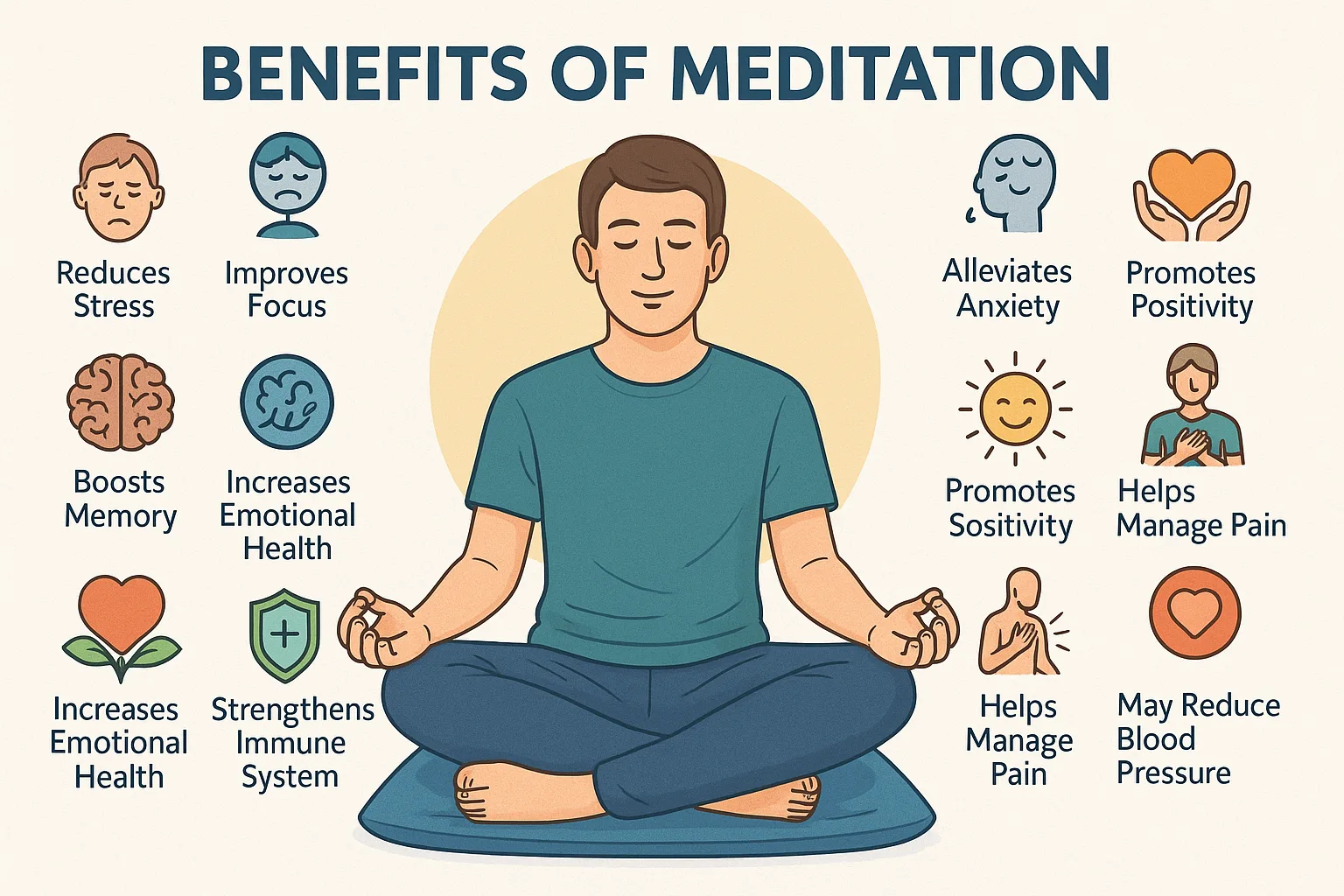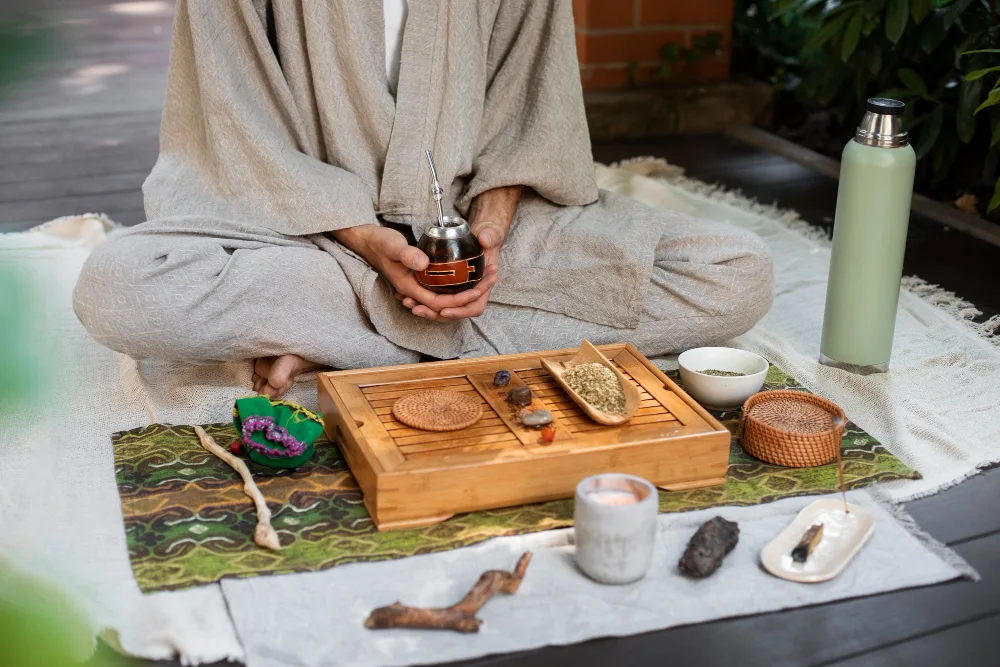Introduction
The alarm rings. Your eyes flutter open. It’s a new day filled with possibilities—or is it just another hectic morning of rushing and stress? For many of us, mornings set the tone for everything that follows. This is precisely why morning meditation has become such a transformative practice for people seeking balance in their increasingly chaotic lives.
I discovered morning meditation during a particularly stressful period in my life when every day felt like running on a hamster wheel. That first 10-minute session changed everything—my focus, my mood, and ultimately, my entire approach to life’s challenges. Now, I’m sharing what I’ve learned about this powerful practice that can revolutionize your mornings and, by extension, your entire day.
In this guide, we’ll explore ten effective morning meditation practices that can help you cultivate inner peace, mental clarity, and a positive mindset before you face the demands of your day. Whether you’re a beginner or looking to revitalize your existing routine, these techniques offer something valuable for everyone.

1. The Simple Breath Awareness Meditation
Starting your day with breath awareness is like setting a foundation of calm for everything that follows. This technique is perfect for beginners and seasoned practitioners alike.
How to practice:
- Find a comfortable seated position
- Close your eyes and take three deep breaths
- Allow your breathing to return to its natural rhythm
- Simply observe each inhale and exhale without trying to change anything
- When your mind wanders (and it will!), gently bring your attention back to your breath
- Continue for 5-10 minutes
What I love about breath awareness meditation is its simplicity. There’s no special equipment needed, no complicated instructions to follow. Just you and your breath, creating a pocket of peace before the day begins.
Many people wonder how long their morning meditation should be. The truth is, even 5 minutes of consistent breath awareness practice can make a difference. Studies show that regular meditation can reduce stress hormones and increase focus—benefits you’ll carry throughout your day.
2. Guided Morning Meditations for Beginners
If you find your mind particularly active in the mornings, guided meditations can be a game-changer. Having someone’s voice direct your attention helps prevent the mind from wandering too far.
Benefits of guided meditations:
- Provides structure for beginners
- Helps maintain focus
- Introduces varied techniques
- Offers expert guidance
I started with guided meditations and still return to them when my mind feels especially scattered. Apps like Calm and Headspace offer morning-specific guided sessions ranging from 5 to 30 minutes, making them perfect for incorporating into your routine regardless of time constraints.
For beginners, I recommend starting with short guided meditations that focus on setting positive intentions for the day. As you build consistency, you can explore more specific practices like gratitude meditations or visualizations.
3. The 5-Minute Mindfulness Check-In

Sometimes mornings are rushed, and the idea of a lengthy meditation feels impossible. That’s where the 5-minute mindfulness check-in becomes invaluable.
The practice:
- Sit comfortably or even remain in bed after waking
- Close your eyes and take three deep breaths
- Scan your body from head to toe, noticing any sensations
- Observe your current emotional state without judgment
- Set one intention for approaching your day mindfully
This quick practice helps you establish a connection with yourself before engaging with the outside world. You might notice tension in your shoulders, excitement about an upcoming meeting, or anxiety about a deadline—whatever arises, simply acknowledge it.
The mindfulness check-in works because it creates a momentary pause between sleep and activity. This brief space allows you to approach your day with greater awareness rather than immediately falling into autopilot mode.
4. Morning Movement Meditation
For those who find sitting still challenging, especially in the morning, movement meditation offers an excellent alternative. This practice combines gentle physical movement with mindful awareness.
Types of morning movement meditations:
- Walking meditation around your home or garden
- Gentle tai chi movements
- Slow, mindful yoga sequences
- Simple stretching with breath awareness
I particularly enjoy combining a few gentle yoga poses with meditation. Starting with child’s pose, moving through a gentle cat-cow sequence, and ending in a seated meditation creates a beautiful bridge between physical awakening and mental centering.
Many people ask if they can combine morning meditation with yoga or other activities, and the answer is absolutely yes! In fact, movement meditation can make your practice more accessible and enjoyable, especially when you’re feeling groggy or restless.
5. Gratitude Meditation Practice

Cultivating gratitude first thing in the morning can profoundly shift your perspective for the entire day. This practice focuses on appreciating what you have rather than immediately thinking about what you need to do or what’s lacking.
“Gratitude makes sense of our past, brings peace for today, and creates a vision for tomorrow.”
— Melody Beattie
How to practice:
- Sit comfortably with eyes closed
- Take several deep breaths to center yourself
- Bring to mind three specific things you’re grateful for
- For each item, really feel the gratitude in your body
- Conclude by setting an intention to notice moments of grace throughout your day
When I started incorporating gratitude meditation into my mornings, I noticed a significant decrease in my tendency to complain or focus on problems. Instead, I began noticing more positive aspects of my day—a shift that research supports as beneficial for mental health.
The beauty of gratitude meditation is that it trains your brain to look for the good, creating a positive feedback loop that extends far beyond your meditation cushion.
6. Setting Intentions Through Meditation
Morning is the perfect time to set clear, positive intentions for your day. Unlike goals, which focus on future achievement, intentions focus on how you want to be in the present moment.
Simple intention-setting practice:
- Begin with 2-3 minutes of breath awareness
- Ask yourself: “How do I want to show up today?”
- Choose one quality you wish to embody (patience, courage, compassion, etc.)
- Visualize yourself expressing this quality throughout your day
- Create a simple phrase or mantra that captures this intention
I find that setting intentions helps me navigate challenging situations with greater poise. When I’ve set an intention to remain patient, for instance, I’m more likely to pause before reacting when faced with frustrating circumstances.
This practice bridges meditation and practical daily life, making it especially valuable for those wondering how meditation impacts productivity and mental clarity throughout the day.
7. Five-Senses Meditation

Engaging all your senses in the morning can help you become fully present and appreciative of the new day. This meditation grounds you in the here and now rather than getting lost in thoughts about the past or future.
The practice:
- Sit comfortably in your meditation space
- Notice 5 things you can see
- Acknowledge 4 things you can touch or feel
- Listen for 3 distinct sounds
- Identify 2 things you can smell
- Notice 1 taste (even if it’s just the taste in your mouth upon waking)
This practice is particularly effective for those mornings when your mind feels scattered or anxious. By deliberately engaging each sense, you anchor yourself in the present moment, creating a foundation of mindfulness.
The five-senses meditation can be done indoors or outdoors, making it versatile for different living situations and seasons. Many people ask whether it’s better to meditate indoors or outdoors in the morning, and the answer depends on your environment and preferences. Outdoor meditation offers connection with nature, while indoor practice provides consistency regardless of weather conditions.
8. Loving-Kindness Morning Meditation
Starting your day by cultivating compassion for yourself and others creates a beautiful foundation for your interactions. This traditional meditation practice helps develop feelings of goodwill, kindness, and connection.
How to practice:
- Begin with several deep breaths
- Direct loving-kindness toward yourself with phrases like: “May I be happy. May I be healthy. May I be safe. May I be at ease.”
- Next, direct these wishes toward someone you love
- Then extend to someone neutral in your life
- Finally, if you’re ready, offer loving-kindness to someone challenging
- Conclude by extending these wishes to all beings
When I first tried loving-kindness meditation, it felt a bit awkward. But over time, I noticed myself becoming more patient in traffic, more understanding with colleagues, and generally more compassionate in my approach to others.
This practice is particularly beneficial if you anticipate a challenging day ahead or need to interact with difficult people. It helps establish a reservoir of goodwill that you can draw upon throughout your day.
9. Morning Visualization Meditation
Visualization harnesses the power of your imagination to create a positive framework for your day. This technique is especially helpful for those facing important events or seeking motivation.
Simple visualization practice:
- After a few minutes of breath awareness, imagine your day unfolding smoothly
- Visualize yourself handling challenges with calm and clarity
- See yourself embodying your best qualities
- Imagine positive interactions with others
- Feel the satisfaction of completing important tasks
- Conclude by returning to breath awareness
I’ve found visualization particularly helpful before important presentations or difficult conversations. By rehearsing success in my meditation, I create a mental path that feels familiar when I actually face the situation.
Research suggests that visualization can improve performance by programming the brain for success. When combined with regular meditation, it becomes even more powerful as a tool for creating positive outcomes.
10. Affirmation Meditation

Using positive affirmations during your morning meditation can help rewire negative thought patterns and build confidence for the day ahead.
How to practice:
- Begin with 3-5 minutes of breath awareness
- Choose 1-3 affirmations that resonate with you
- Repeat each affirmation slowly, feeling the truth of the words
- Notice any resistance that arises and acknowledge it without judgment
- Return to the affirmations, allowing them to sink deeper
Effective morning affirmations:
- “I am capable of handling whatever comes my way today”
- “I choose peace and clarity in all situations”
- “My challenges help me grow stronger”
- “I am worthy of success and happiness”
When I first tried affirmation meditation, I felt skeptical. The statements seemed artificial, and my mind argued against them. But I discovered that with consistent practice, these positive statements began to feel more natural and true, gradually replacing my habitual negative thinking.
This practice is especially beneficial for those struggling with self-doubt or anxiety. By consciously choosing supportive thoughts at the beginning of your day, you set a positive tone that can carry you through challenges.
Creating Your Personalized Morning Meditation Routine
Now that we’ve explored ten powerful meditation practices, let’s address how to build a consistent routine that works for your lifestyle.
Tips for establishing a morning meditation habit:
- Start small: Begin with just 5 minutes daily rather than aiming for long sessions
- Create a dedicated space: Designate a specific area for your practice
- Practice at the same time: Consistency helps form habits
- Use technology mindfully: Consider using meditation apps for guidance and tracking
- Be flexible: Some mornings might allow for longer sessions, others might be quick check-ins
The most important aspect of a morning meditation practice is consistency rather than duration. Five minutes every day is more beneficial than 30 minutes once a week.
For those wondering about equipment, the good news is that you need very little to get started. A comfortable cushion or chair, perhaps a timer, and maybe an app for guidance are all that’s required. As your practice deepens, you might choose to add elements like a meditation cushion, essential oils, or a special journal to record insights.
Essential Tools for Morning Meditation

While meditation requires no special equipment, certain tools can enhance your practice and help maintain consistency.
Helpful meditation tools:
- Meditation apps: Calm, Headspace, and Insight Timer offer guided morning meditations for all levels
- Comfortable seating: Options range from traditional cushions to meditation chairs
- Gentle alarms: Products like the Hatch Restore wake you gradually for a more mindful transition
- Journals: Recording insights from your practice helps deepen the experience
- Aromatherapy: Diffusers with essential oils can create a calming atmosphere
I’ve found that having a dedicated meditation space with minimal distractions makes a significant difference in the quality of my practice. Even something as simple as a special cushion signals to my brain that it’s time to settle into mindfulness.
For beginners wondering if they can meditate effectively, remember that meditation is a skill that improves with practice. Using guided meditations through apps or videos can provide helpful structure as you develop your practice.
The Science Behind Morning Meditation
The benefits of morning meditation aren’t just anecdotal—they’re backed by science. Understanding the research can provide extra motivation on days when your practice feels challenging.
Research-supported benefits of morning meditation:
- Reduced stress response: Regular meditation lowers cortisol levels
- Improved focus: Meditation enhances attention span and concentration
- Better emotional regulation: Practitioners show improved ability to manage difficult emotions
- Enhanced immune function: Studies indicate meditation may strengthen immune response
- Increased cognitive flexibility: Regular meditators demonstrate greater mental adaptability
One study published in the Journal of Positive Psychology found that just 15 minutes of meditation can help people make more rational decisions and think more clearly when facing problems—exactly what most of us need as we begin our day.
Understanding these benefits helps explain why morning meditation impacts mental clarity and productivity throughout the day. The effects extend far beyond the meditation cushion, influencing how you respond to challenges, interact with others, and maintain focus on important tasks.
FAQ: Common Questions About Morning Meditation
What is morning meditation, and why is it beneficial?
Morning meditation is the practice of mindfulness, awareness, or contemplation performed early in the day, typically shortly after waking. It’s beneficial because it establishes a calm, centered foundation before daily activities begin. Morning practice takes advantage of the brain’s heightened receptivity after sleep, helping set a positive tone that can carry throughout your day.
How long should a morning meditation session be?
Effective morning meditation can be as brief as 5 minutes or as long as an hour. For beginners, starting with 5-10 minutes is ideal. Consistency matters more than duration—a short daily practice yields greater benefits than occasional lengthy sessions. As your practice develops, you might naturally wish to extend your meditation time.
What is the best type of meditation to practice in the morning?
The “best” type depends on your personal needs and preferences. Breath awareness and mindfulness are excellent foundations. If you’re seeking energy, try a walking meditation or gentle movement practice. For emotional balance, loving-kindness meditation works well. For clarity and focus, a simple mindfulness practice is ideal. Experiment with different methods to discover what resonates most with you.
Can I combine morning meditation with other activities like yoga or journaling?
Absolutely! Many practitioners create morning rituals that combine meditation with complementary practices. Gentle yoga can prepare the body for seated meditation, while journaling afterward helps capture insights. The key is maintaining mindful awareness throughout these activities rather than rushing through them mechanically.
Is it better to meditate indoors or outdoors in the morning?
Both settings offer unique benefits. Indoor meditation provides consistency, privacy, and control over your environment. Outdoor meditation connects you with nature and can enhance your practice through natural sounds and fresh air. Weather permitting, try both to see which environment helps you feel more present and focused. Some practitioners alternate between settings based on seasons or needs.
Can beginners practice morning meditation effectively?
Yes! Morning meditation is accessible to everyone, regardless of experience. Beginners often find that using guided meditations, starting with short sessions, and maintaining reasonable expectations helps establish a successful practice. Remember that meditation is a skill that develops over time—consistency matters more than perfection.
Conclusion: Embracing the Morning Meditation Journey
Morning meditation isn’t just a practice—it’s a gift you give yourself each day. By carving out even a few minutes for mindfulness before engaging with the demands of your day, you create a foundation of calm, clarity, and intention that influences everything that follows.
I encourage you to approach your morning meditation journey with curiosity and compassion. Some days your mind will feel clear and focused; other days it may wander constantly. Both experiences are perfectly normal parts of the practice. What matters is showing up consistently and bringing gentle awareness to whatever arises.
Remember that transformation happens gradually. The small act of sitting in meditation each morning creates ripples that extend far beyond those few minutes. Over time, you may notice greater patience in traffic, more presence in conversations, improved focus at work, and a general sense of being grounded amidst life’s inevitable challenges.
I invite you to begin tomorrow morning. Choose one of the practices described in this guide, set aside five minutes after waking, and simply begin. Your future self will thank you for this daily investment in mental clarity and emotional well-being.
What morning meditation practice resonates most with you? Have you experienced benefits from meditating early in the day? Share your experiences in the comments below—I’d love to hear about your journey.
Attention! Freebie!





